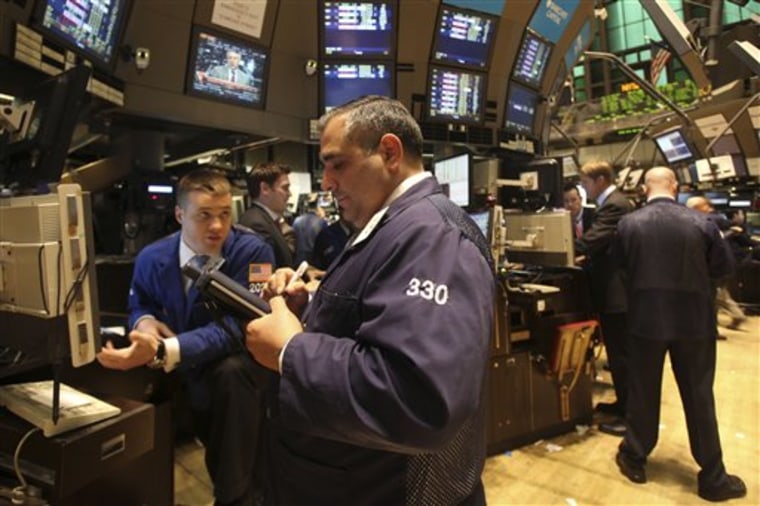The first quarter on Wall Street was so extreme it included a bear market and a bull market all its own — moves that sometimes take years or more. Now investors head for spring still unsure which side is in control.
From the second week of the year to early March, the Dow Jones industrial average lost more than a quarter of its value, plunging from just above 9,000 to below 6,550. Retirement accounts were suddenly worth half what they were in 2007.
Then came a rally that left investors' heads spinning. Over just 13 trading days, the Dow soared 21 percent, bouncing back almost to 8,000.
When the dust settled, the stock market was left with its sixth straight quarter of declines, the first time that's happened since 1969 and 1970. For the Dow, it was the worst start to the year since 1939.
So what now? The answer could be found in a mixture of economic reports that will help Wall Street determine whether there really is hope that the recession, among the longest since the Great Depression, is turning around — or at least stabilizing.
Manufacturing reports coming this week will give investors clues about whether business is picking up, and the March employment report will shed light on whether the job market pain is still getting worse.
"There was no light at the end of the tunnel in January and February. Now there's some," said Hugh Johnson, chief investment officer at Johnson Illington Advisors in Albany, N.Y. "It's very, very faint."
On Tuesday, the Dow finished at 7,608.92, a gain of more than 1 percent for the day, still looking a lot better than the lows of early March. Just a day earlier, the market showed its fragility: The Dow plunged 254 points after President Barack Obama rejected the restructuring plans of General Motors and Chrysler.
The companies that did best in the March rally showed traders were betting that a stabilizing economy would mean higher demand for natural resources and electronics. Stock in Alcoa, which makes aluminum, rallied 40.6 percent off its lows.
Cisco Systems, which makes computer networking gear, had a 23 percent bounce. And demand for technology stocks made the Nasdaq index the standout among major market averages. It fell only 3 percent for the quarter.
Bank and automotive stocks were among the hardest hit during the quarter. Citigroup actually fell below $1 a share and finished Tuesday at a still paltry $2.53. GM, once a titan of American industry, now trades below $2.
In a fractious quarter for the stock market, each month was remarkable. The Dow had its worst January ever and worst February since the Depression, then, in March, turned in its best month in six years.
At the end of last year, some were wondering if the worst of the plunge might be over. The Dow had staged a 16 percent rally in November and December. But it turned out investors still had a list of worries longer than a roll of ticker tape.
Banks were still struggling with bad debt, people were losing their jobs by the hundreds of thousands and whole neighborhoods were succumbing to home foreclosures. Wall Street had few details on how the government planned to rescue the banks.
The slide was so relentless that if your 401(k) account was worth $100,000 at the peak of the market in 2007, you would have had about $43,000 in early March, not counting dividends and additional contributions.
Then, on March 10, came a turnaround. The chief of Citigroup said the bank was profitable in January and February. Other banks followed. Home sales and other economic reports came in surprisingly upbeat.
"It's very possible that the lows we put in in March were the lows that hold for the rest of our lives," said Jerry Jordan, portfolio manager at the Jordan Opportunity Fund in Boston.
Of course, the day-to-day swings on Wall Street can still be wrenching, as they have been since the financial meltdown of last September. Just last week the Dow soared almost 500 points in a day. And it fell more than 400 over Friday and Monday.
"I'm kind of skeptical about market fluctuations. I'm not making any new investments for a while," said Howard Green, a retiree in New York.
The market is still being driven by institutional investors such as mutual funds and hedge funds. Small investors are more wary. Even with the gains in March, investors have pulled more than $30 billion out of U.S. stock funds this year, according to TrimTabs Investment Research.
Analysts do see signs the market is in a healthier frame of mind. What's known as Wall Street's fear gauge, the Chicago Board Options Exchange Volatility Index, stands at 44. It trades around 30 in less turbulent times but was above 80 in November.
The stock market tends to trade on investors' expectations for how business will look six months to a year down the line. So the outlooks that companies issue with their earnings reports in April will be critical to whether Wall Street goes bull or bear.
Quincy Krosby, chief investment strategist at The Hartford, expects that, at best, the market will hold its gains but not push much higher as investors examine the coming quarterly reports from companies. "Going sideways," she said, "would be a victory."
